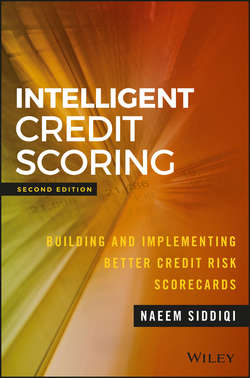Intelligent Credit Scoring

Реклама. ООО «ЛитРес», ИНН: 7719571260.
Оглавление
Siddiqi Naeem. Intelligent Credit Scoring
More Praise for Intelligent Credit Scoring
Wiley & SAS Business Series
Acknowledgments
Chapter 1. Introduction
Scorecards: General Overview
Chapter 2. Scorecard Development: The People and the Process
Scorecard Development Roles
Intelligent Scorecard Development
Scorecard Development and Implementation Process: Overview
Chapter 3. Designing the Infrastructure for Scorecard Development
Data Gathering and Organization
Creation of Modeling Data Sets
Data Mining/Scorecard Development
Validation/Backtesting
Model Implementation
Reporting and Analytics
Chapter 4. Scorecard Development Process, Stage 1: Preliminaries and Planning
Create Business Plan
Create Project Plan
Why “Scorecard” Format?
Chapter 5. Managing the Risks of In-House Scorecard Development
Human Resource Risk
Technology and Knowledge Stagnation Risk
Chapter 6. Scorecard Development Process, Stage 2: Data Review and Project Parameters
Data Availability and Quality Review
Data Gathering for Definition of Project Parameters
Definition of Project Parameters
Segmentation
Methodology
Review of Implementation Plan
Chapter 7. Default Definition under Basel
Introduction
Default Event
Prediction Horizon and Default Rate
Validation of Default Rate and Recalibration
Application Scoring and Basel II
Summary
Chapter 8. Scorecard Development Process, Stage 3: Development Database Creation
Development Sample Specification
Sampling
Development Data Collection and Construction
Adjusting for Prior Probabilities
Chapter 9. Big Data: Emerging Technology for Today’s Credit Analyst
The Four V’s of Big Data for Credit Scoring
Credit Scoring and the Data Collection Process
Credit Scoring in the Era of Big Data
Ethical Considerations of Credit Scoring in the Era of Big Data
Conclusion
Chapter 10. Scorecard Development Process, Stage 4: Scorecard Development
Explore Data
Missing Values and Outliers
Correlation
Initial Characteristic Analysis
Preliminary Scorecard
Reject Inference
Final Scorecard Production
Choosing a Scorecard
Validation
Chapter 11. Scorecard Development Process, Stage 5: Scorecard Management Reports
Gains Table
Characteristic Reports
Chapter 12. Scorecard Development Process, Stage 6: Scorecard Implementation
Pre-implementation Validation
Strategy Development
Chapter 13. Validating Generic Vendor Scorecards
Introduction
Vendor Management Considerations
Vendor Model Purpose
Model Estimation Methodology
Validation Assessment
Vendor Model Implementation and Deployment
Considerations for Ongoing Monitoring
Ongoing Quality Assurance of the Vendor
Get Involved
Appendix: Key Considerations for Vendor Scorecard Validations
Chapter 14. Scorecard Development Process, Stage 7: Post-implementation
Scorecard and Portfolio Monitoring Reports
Reacting to Changes
Review
Appendix A: Common Variables Used in Credit Scoring
Appendix B: End-to-End Example of Scorecard Creation
Bibliography
About the Author
About the Contributing Authors
WILEY END USER LICENSE AGREEMENT
Отрывок из книги
The Wiley & SAS Business Series presents books that help senior-level managers with their critical management decisions.
Titles in the Wiley & SAS Business Series include:
.....
Scorecard characteristics may be selected from any of the sources of data available to the lender at the time of the application. Examples of such characteristics are demographics (e.g., age, time at residence, time at job, postal code), existing relationship (e.g., time at bank, number and types of products, payment performance, previous claims), credit bureau (e.g., inquiries, trades, delinquency, public records), real estate data, and so forth. The selection of such variables and creation of scorecards will be covered in later chapters in much more detail.
Each attribute (“age” is a characteristic and “23–25” is an attribute) is assigned points based on statistical analyses, taking into consideration various factors such as the predictive strength of the characteristics, correlation between characteristics, and operational factors. The total score of an applicant is the sum of the scores for each attribute present in the scorecard for that applicant.
.....